Lessons from Teotihuacan
What the ruins of a pre-Aztec metropolis can teach us about today’s cities
It’s a sunny summer Sunday, and the Street of the Dead looks particularly lively as archaeologist David Carballo makes his way across. The broad thoroughfare cuts a one-and-a-quarter-mile swath through the heart of the ancient Mesoamerican city of Teotihuacan, passing three monumental stone pyramids named after the sun, the moon, and the mythological Feathered Serpent, and gaggles of photo-snapping tourists. About 30 miles northeast of Mexico City, Teotihuacan—or Teo, as archaeologists call it—is a UNESCO World Heritage Site and the most visited archaeological ruin in the Western Hemisphere. Today, as in ancient times, the center of Teo is a circus of commerce. One vendor hawks colorful clay whistles that trill a birdsong or rumble a jaguar’s growl. Another sells dangling pendants of serpents, skulls, plastic hearts, and peace signs. A group of friendly tourists stops Carballo, waggling their iPhones toward him, asking him to take their photo. They lean together, grinning from ear to ear, pyramids looming behind them.
Carballo, a Boston University College of Arts & Sciences (CAS) assistant professor of archaeology and author of Urbanization and Religion in Ancient Central Mexico (Oxford University Press, 2015), has studied Teotihuacan since 1999, trying to learn how this ancient metropolis arose around the first century BCE and flourished for more than 600 years. He does this not by studying the grand pyramids and other remnants of Teo’s elite, but by examining a group of working-class neighborhoods in a district called Tlajinga. Carballo, who teaches a class called Archaeology of Cities and whose work is funded by a three-year, $238,000 National Science Foundation (NSF) grant, says that understanding the economics and social structure of Tlajinga will give him clues to the economics and social structure of the city as a whole. That knowledge, in turn, may inform a host of questions about our modern cities: Who migrates to cities and why? How do rulers build and maintain complex infrastructure? And perhaps most crucial for our diverse society, how can a government attract strivers from many different cultures and mold them into a new, unified people? In other words, how can we all get along?
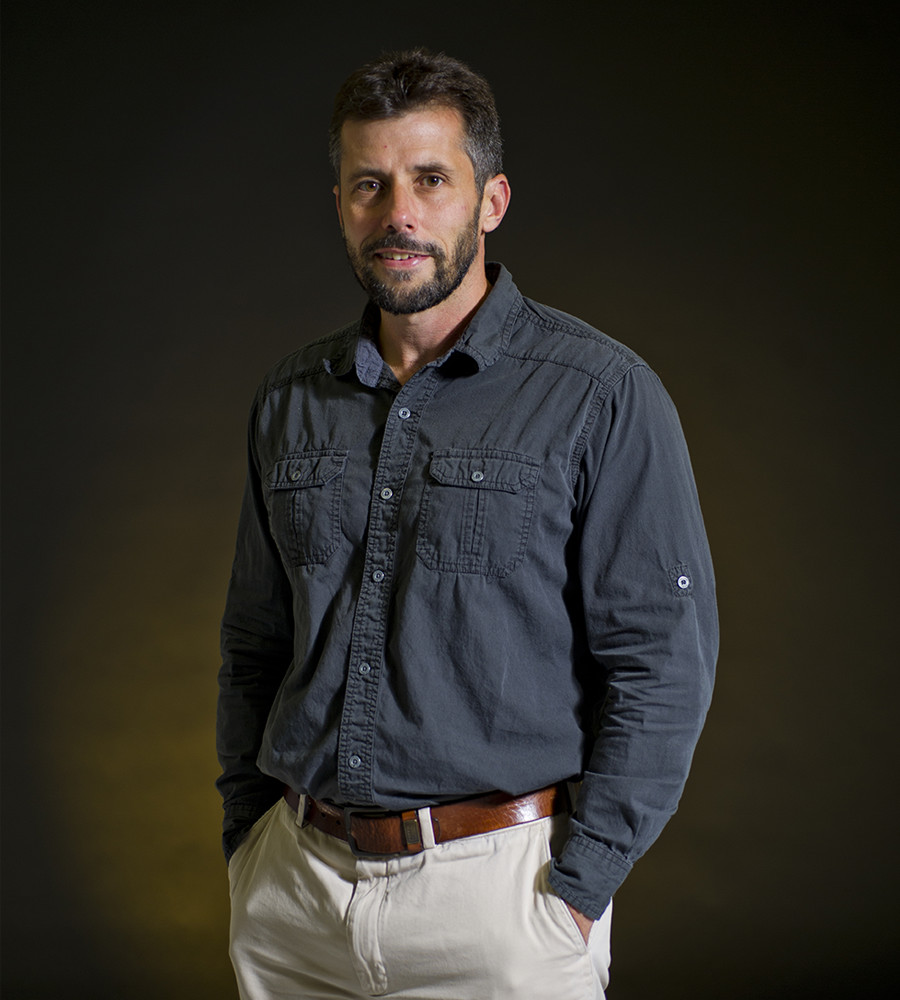 David Carballo. Photo by Cydney Scott
David Carballo. Photo by Cydney ScottMore than half the people in the world now live in cities, according to the World Health Organization, and as more people migrate to urban areas, finding answers to these questions becomes urgent. “Comparing ancient cities to modern cities is long overdue, and David Carballo has been at the forefront of this movement,” says George Cowgill, an Arizona State University (ASU) professor emeritus of archaeology, who is regarded as the world’s authority on Teotihuacan. Cowgill says that Carballo’s focus on the Tlajinga district, as well as other places, is critical for understanding the city at large. “Imagine studying Boston by just looking at the State House and a few skyscrapers—it’s ridiculous,” he says. “We need to know the whole range of the city, from the commoners to the elites.”
Carballo’s work is part of a scientific trend, says Curtis Runnels, a CAS professor and chair of archaeology, pointing to comparable studies in Pompeii and Giza. “In the early days of scientific archaeology, they focused on the big things they could see: temples, tombs, King Tut, and the whole business,” says Runnels. “Archaeologists have moved beyond that.”
“Teotihuacan is from the same time period—and it’s the same scale—as ancient Rome,” Runnels adds. “Who were the inhabitants and where did they come from? How did they organize such a city? You don’t answer those questions by looking at pyramids alone.”
Beyond the pyramids
The pyramids are good for one thing, at least: a sweeping view of the city. From a distance, the parade of tourists climbing the 248 steps to the top of the Sun Pyramid looks like a trail of determined ants. Carballo makes his way to the summit and points out Tlajinga, just over a mile to the south, and ethnic enclaves elsewhere in the city that housed Zapotec, Maya, and people from Mexico’s Gulf Coast. Like many modern cities, Teo had a compact downtown area arranged on an orderly grid, with temples, open market plazas, and stylish, elite apartment housing. Simpler neighborhoods like Tlajinga arose at a distance from downtown, as did Brighton to downtown Boston. Archaeologists estimate that Teo encompassed about eight square miles, with more than 100,000 inhabitants at its peak. For comparison, medieval London covered only about one square mile and its population didn’t break 100,000 until the 16th century.
An Affinity for Harmony

How Teo achieved and maintained its impressive size and population has intrigued archaeologists for centuries. Large-scale excavations, of varying quality, began in the early 1900s. In the 1960s, archaeologists with the ambitious Teotihuacan Mapping Project created a detailed map of the city by surveying about 14 square miles of land and collecting every scrap of ancient material they saw, including nearly 900,000 fragments of pottery and 230,000 pieces of the volcanic glass called obsidian. Archaeologists say that Teotihuacan may have thrived, in part, anyway, because of the city’s focus on harmony and cooperation. “Whoever ruled Teotihuacan did not emphasize the individual,” Carballo says. The colorful murals they painted, for instance, highlight timeless themes of fertility and abundance and show priests or warriors standing in a line, with none clearly prominent. Teo’s elaborate urban planning also demonstrates this affinity for harmony. The Street of the Dead, for instance, does not run directly north to south, but instead veers exactly 15.5 degrees off that line. This offbeat angle sets the Pyramid of the Moon directly in front of Cerro Gordo Mountain so that it forms a perfect backdrop, and allows spectators on the Pyramid of the Sun to view the sunset through craggy mountain valleys on key days in the calendar. Teotihuacanos also altered the course of the San Juan River to conform to their city’s grid. Originally draining southwest, the river now flows directly south, banks sharply west at an almost right angle, then flows south again. “It’s for cosmic harmony,” says Carballo. “You can’t have a meandering river right at the center of creation.”
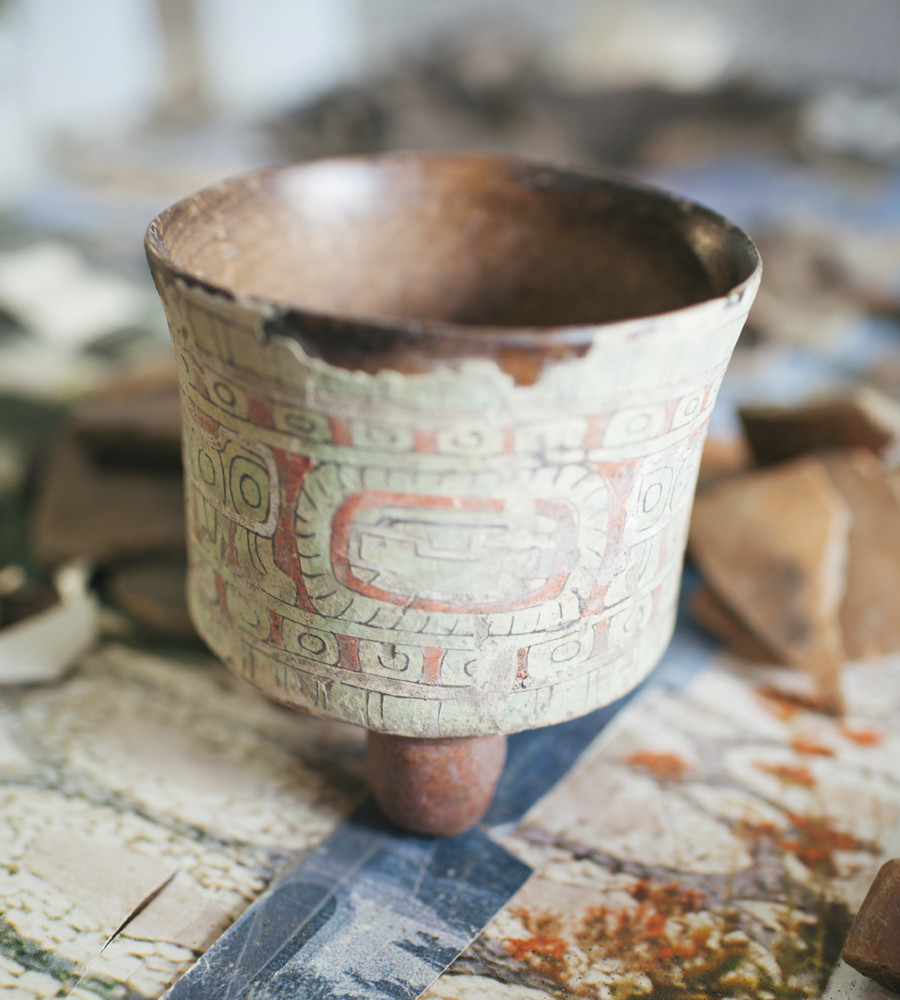 Ceramic tripod vase from Tlajinga, one of the team’s key finds. The colored motifs mirror large murals in downtown Teotihuacan. Photo by Alicia Vera
Ceramic tripod vase from Tlajinga, one of the team’s key finds. The colored motifs mirror large murals in downtown Teotihuacan. Photo by Alicia VeraWhile the bustling and organized city center may have contributed to civic pride, it also required a lot of upkeep. As Carballo puts it, “You need a lot of people carrying a lot of baskets full of stone and rubble.” He says that a labor tax was probably an essential part of the economy, with residents owing days of work to their neighborhood, to the city, and to a temple or palace as well.
Why would anyone immigrate to a city where they had to lug rubble to build pyramids? That’s the question that draws Carballo to Tlajinga. “We know why the elites would want to live here, but what’s in it for the other 80 percent?” he asks. “It’s one of the great dilemmas: how do you get people to cooperate on this scale? The temples are part of it, getting people to buy into being part of this cosmic plan. But the practical side of me knows there has to be some material gain.”
Carballo steers his pickup truck down a rutted dirt road and pulls off into a scrubby, overgrown field. It’s an unpromising spot for archaeological insight: dotted with spiky stands of prickly pear cactus and bisected by high-voltage power lines. A freight train rumbles past as a mob of chickens clucks and crows nearby. “Here it is,” says Carballo, stepping out of the truck and shutting the door behind him. “Tlajinga—in all its glory.”
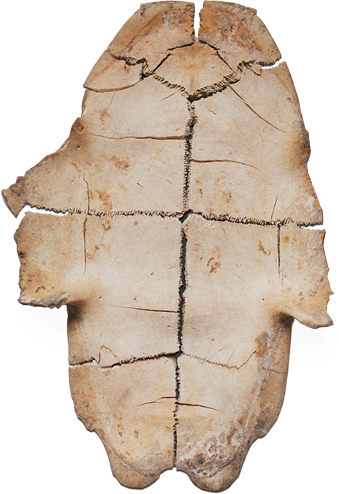 Belly side of a turtle shell found in Tlajinga, probably part of a hand-held rattle drum. Items like these tell Carballo that people in the neighborhood had a high standard of living. “You can see why this city was a draw.” Photo by Alicia Vera
Belly side of a turtle shell found in Tlajinga, probably part of a hand-held rattle drum. Items like these tell Carballo that people in the neighborhood had a high standard of living. “You can see why this city was a draw.” Photo by Alicia VeraHe walks to a massive anthill and points to some tiny black flakes in the gravel around it: obsidian. The ground is littered with it. “These tiny little chips indicate an obsidian workshop—people who were just using obsidian tools wouldn’t leave a zillion little flakes behind.” A visitor stoops down for a closer look. “Watch out,” says Carballo, “those are fire ants.”
Ancient people used obsidian to craft blades, spear points, scrapers, and beads, and it’s the key to understanding the economy of Tlajinga. To make obsidian tools, workers delicately peeled thin blades off a hefty core—a skilled process called knapping —leaving bits and pieces and chunks and shards behind. These scraps allow patient archaeologists to precisely reconstruct the sequence of production, learning who made what, and where.
Exploring obsidian in Tlajinga
This information is critical for understanding Teo. Because the ground at Tlajinga is so rich in obsidian, archaeologists have speculated that the city had hundreds of workshops. But those workshops would have produced far more tools than the inhabitants of Teo could use. “You don’t need that many craftsmen,” says Carballo’s colleague Ken Hirth, a Pennsylvania State University professor of anthropology. “So what’s going on?” Some scientists suggest that Teo was a regional manufacturing hub, with a strong central government controlling obsidian supply and trade. Others say the workshop estimates were simply overblown. Carballo thought that digging there might help settle the debate.
The Engine of the Economy

In summers 2013 and 2014, Carballo, his students, and colleagues excavated parts of two multihousehold apartment blocks at Tlajinga. They recovered thousands of pieces of pottery and bone, and about one million pieces of obsidian—more than 900 pounds. Carballo’s students and colleagues are now analyzing the artifacts in the ASU-managed Teotihuacan Research Laboratory in nearby San Juan, and they are already gaining a deeper understanding of the ancient economy. At the lab, Hirth picks up one of his favorite artifacts—a near-perfect obsidian pressure core. Black and shiny as anthracite coal, the core is a cylinder, tapered at one end, a bit smaller than a liter bottle of water. Shallow grooves run down the sides—places where a master craftsman could press off sharp blades of obsidian. “This guy had a load of talent, because there’s not an error on here,” Hirth says. He grabs a core from a nearby table for comparison. Stubby and chipped, it looks like a hunk of rock that had been chucked out a car window and found lying on the roadside. It was decidedly not the work of a master.
Apartment life in Teo
To the archaeologists, these finds are evidence of an obsidian workshop housing crafters with different levels of skill. This seems to indicate that individual workshops managed by master craftsmen, rather than an all-powerful state government, drove obsidian production and innovation. “We can only reconstruct a model of economic activity based on what we know,” says PhD candidate David Walton (GRS’19), who is analyzing a portion of the obsidian artifacts found at Tlajinga. “If all that’s been excavated and analyzed are the big institutions, you’re going to say they’re controlling the economy. But the more we excavate households in Mesoamerica, the more we realize that domestic economies are the engine that’s driving the whole economic system. It’s coming from the ground up.”
Carballo’s biggest surprise during the Tlajinga excavation was the range and quality of goods found in this working-class enclave: turtle shells and a bone rasp that were probably musical instruments, a delicately painted ceramic vessel, a rare life-size stone mask. “The take-home message is that even poorer people in Teo lived pretty well,” he says. “You can see why this city was a draw.”
Clues from compound 18
Over the next three years, Carballo, along with colleagues Saburo Sugiyama of ASU and Nawa Sugiyama of the Smithsonian Institution, will begin a new NSF-sponsored excavation at Teotihuacan, at a likely palace complex called the Plaza of the Columns. The complex sits in an overgrown field where large grassy mounds probably cover temples. But Carballo isn’t interested in temples, impressive as they may be. He’ll be excavating an out-of-the-way area tucked behind one of the mounds, looking for storage areas, kitchens, or living quarters of a servant class, to help him better understand the politics of the ancient Teotihuacano economy. He hopes to find parallels to Tlajinga, in how commoners interacted with power.
“In Tlajinga, you could be a humble craftsman and still have a niche within the economy,” he says. “People had really nice houses, with courtyards and drains, and access to goods from all over. You had minerals coming from the north, shells coming from the coast, jade from the Maya region. People were moving, ideas were moving with them, and Teo became celebrated. People recognized, OK this is the biggest game in town.”
Teo wasn’t just an economic hub, according to Carballo—it was a political, cultural, and religious center. It had ball games and grand temples and gambling. The same things that drew migrants to Teo are the things that draw immigrants to cities today: better entertainment, bigger ideas, diverse people, different food, and of course, a shot at a better life.
“There’s a quote that’s attributed to Mark Twain—‘History doesn’t repeat itself, but it often rhymes,’” he says. “You see these patterns, these ripples. The way that humans tend to do things resonates into later generations.”


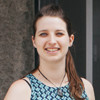 Maria
Maria David
David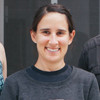 Daniela
Daniela Photos by Alicia Vera
Photos by Alicia Vera
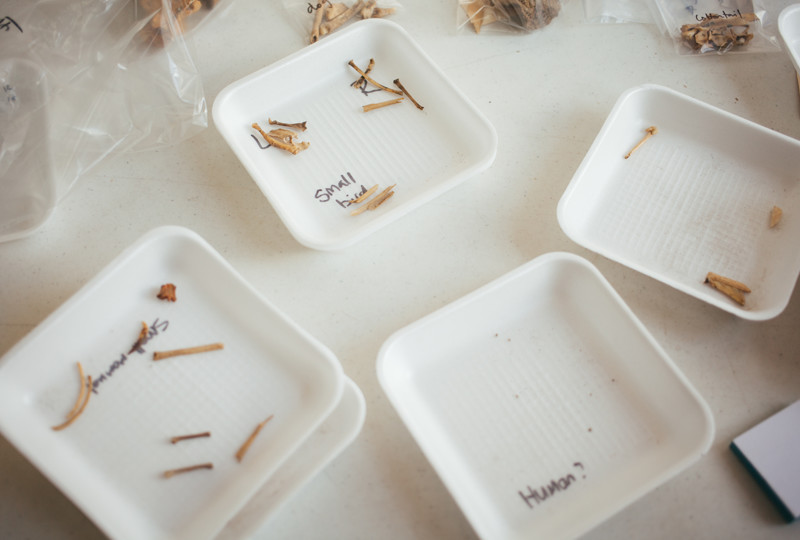 Photos by Alicia Vera
Photos by Alicia Vera
 Photos by Alicia Vera
Photos by Alicia Vera
 Photos by Alicia Vera
Photos by Alicia Vera
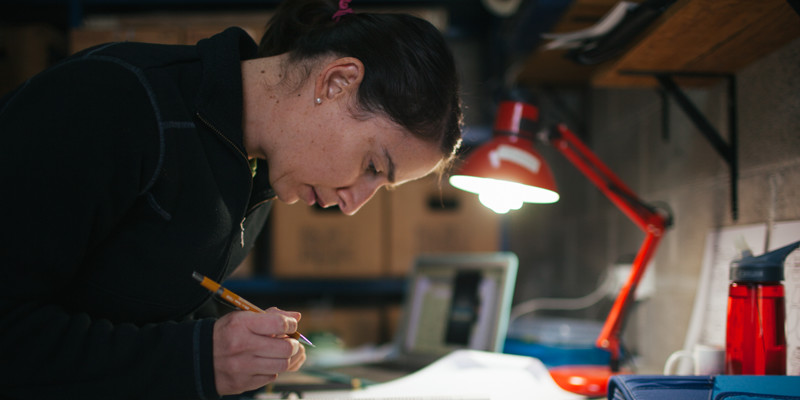 Photos by Alicia Vera
Photos by Alicia Vera
 Photos by Alicia Vera
Photos by Alicia Vera
Comments & Discussion
Boston University moderates comments to facilitate an informed, substantive, civil conversation. Abusive, profane, self-promotional, misleading, incoherent or off-topic comments will be rejected. Moderators are staffed during regular business hours (EST) and can only accept comments written in English. Statistics or facts must include a citation or a link to the citation.